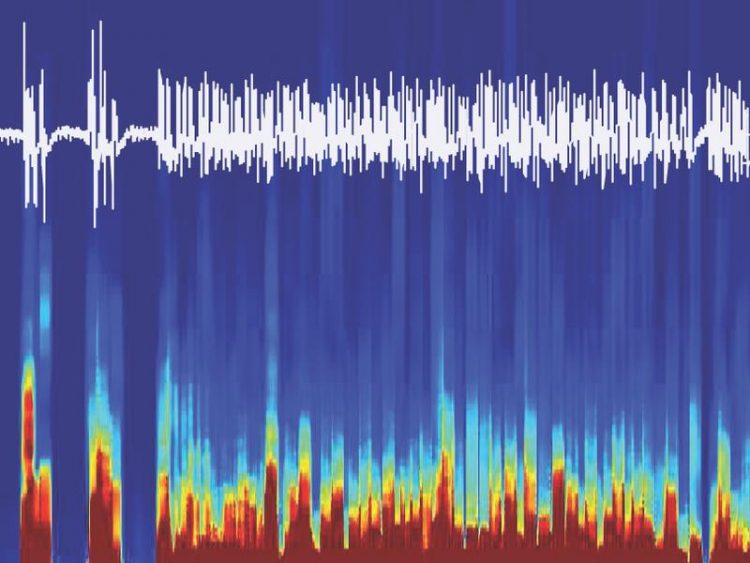How the brain wakes you up

Arousal power of the discovered circuit: Illustration of an emergence from anesthesia shown on the EEG recordings from the mouse brain controlled with optogenetic. Department of Clinical Research, University of Bern
Chronic sleep perturbances affect 10-20% of the population of Switzerland and almost everyone experiences sleep problems at least once in a lifetime. Beside the quantity of sleep that is often affected in insomnia, clinical and experimental studies emphasize that the quality of sleep (e.g., depth of your sleep) is equally important for a good night’s sleep and a complete recovery of «body and mind» functions.
«The consequences of sleep perturbations on life quality go far beyond daytime sleepiness and mood alteration. Cognitive impairment, hormonal imbalance and high susceptibility to cardiac or metabolic disorders are amongst some of the negative impacts frequently associated with subtle chronic sleep problems», says Prof. Antoine Adamantidis from the Department of Clinical Research of the University of Bern and Department of Neurology at the Bern University Hospital.
The quantity and the quality of sleep are now considered as an early marker of many neurological disorders including Alzheimer’s disease, Parkinson’s disease, and schizophrenia. Unfortunately, pharmaceutical strategies combined with improved life hygiene have limited effect. «Personalized medicine» strategies for the treatment of either insufficient sleep quality or quantity are missing.
Brain circuits for arousal and consciousness
Therefore, intensive experimental research is conducted to understand how brain circuits control sleep-wake cycle and consciousness – an enigma in modern Neurosciences and an exciting key mystery to resolve.
Together with fellow researcher Carolina Gutierrez Herrera and colleagues from Germany, Adamantidis made a dual discovery: his team identified a new circuit in the brain of mice whose activation causes rapid wakefulness while its inhibition deepens sleep.
The study was published in the scientific journal «Nature Neuroscience».
Mammalian sleep is classically divided in two phases, including non-rapid eye movement (NREM) sleep or «light» sleep, and REM (or paradoxical) sleep or «deep»/dreaming sleep. Key brain circuits for those two states have been identified.,However, the precise underlying mechanisms – such as the onset, maintenance and termination of sleep and dreaming – remain unknown.
Adamantidis and Gutierrez Herrera identified a new neural circuit between two brain regions called hypothalamus and thalamus, which have been associated with EEG (electroencephalogram) rhythms during sleep. The activation of this circuit signals the termination of light sleep: using a recent technology called optogenetics, the researchers made neurons from the hypothalamus controllable with millisecond-timescale light pulses and showed that their transient activation during light sleep induced rapid awakenings, while their chronic activation maintains prolonged wakefulness.
In contrast, optogenetic silencing of this circuit stabilizes light sleep and increases its intensity. In a translational analogy, hyperactivity of this circuit may cause insomnia, while its hypo-activity could be responsible for hypersomnia, making it a new therapeutical target for sleep disorders.
Causing emergence from anesthesia and unconsciousness
Interestingly, the arousal power of this circuit is so strong that its activation precipitates emergence from anesthesia and the recovery of consciousness. «This is exciting discovery since therapeutical approaches to recover from a vegetative or minimally conscious state are quite limited», says Adamantidis. Non-selective deep brain electrical stimulation has been used with some success, however the underlying brain mechanisms remain unclear. In this study, Adamantidis, Gutierrez Herrera and collaborators nailed down a selective brain circuit important for the recovery of consciousness.
The dual findings of the Bernese researchers shine light on the brain mechanism of arousal and opens new door for tailored medical treatment of sleep perturbances, and provide a roadmap for arousing patients from a vegetative or minimally conscious state. However, Adamantidis emphasizes that «even though we made an important step forward now, it will take some time before novel therapeutical strategies will be designed based on our results».
Publication details:
Carolina Gutierrez Herrera, Marta Carus Cadavieco, Sonia Jego, Alexey Ponomarenko, Tatiana Korotkova and Antoine Adamantidis. Hypothalamic feed-forward inhibition of thalamocortical network controls arousal and consciousness. Nature Neuroscience 2015 (In Press)
Media Contact
All latest news from the category: Life Sciences and Chemistry
Articles and reports from the Life Sciences and chemistry area deal with applied and basic research into modern biology, chemistry and human medicine.
Valuable information can be found on a range of life sciences fields including bacteriology, biochemistry, bionics, bioinformatics, biophysics, biotechnology, genetics, geobotany, human biology, marine biology, microbiology, molecular biology, cellular biology, zoology, bioinorganic chemistry, microchemistry and environmental chemistry.
Newest articles

NASA: Mystery of life’s handedness deepens
The mystery of why life uses molecules with specific orientations has deepened with a NASA-funded discovery that RNA — a key molecule thought to have potentially held the instructions for…

What are the effects of historic lithium mining on water quality?
Study reveals low levels of common contaminants but high levels of other elements in waters associated with an abandoned lithium mine. Lithium ore and mining waste from a historic lithium…

Quantum-inspired design boosts efficiency of heat-to-electricity conversion
Rice engineers take unconventional route to improving thermophotovoltaic systems. Researchers at Rice University have found a new way to improve a key element of thermophotovoltaic (TPV) systems, which convert heat…



